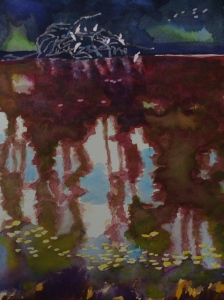
Our backyard is blessed with fruit trees. In early summer, the apricots and plums ripen and soon find their way as jam, the taste of sunshine on a winter’s day. And now with fall’s arrival the Flanders Fig has ripened; with the pear and persimmon trees soon to follow. This week we will celebrate Sukkot, the Jewish agricultural festival celebrating the harvest. And so we tend to our figs. Even in this severe drought the trees are doing their utmost to participate in the cycle of life; and for this I am grateful and give thanks. But I worry. How much longer can they last with such little rain? Come hither El Nino, and when you come, don’t be shy, bring your entire Cumulonimbus family.
Harvested figs have become star performers in a galette, in salads, and rumors in our home, suggest a caramelized future for pizza pies. We planted the fig tree five years ago and over the years, we have tended the tree, watering, pruning branches, and building supports ensuring it would could grow tall and strong. This is the first bountiful harvest, so we eagerly await the fruit. The tree stands over fifteen feet in height, it’s branches tending towards the sun to help ripen the fruit. Figs are a favorite of the creatures with which we share this Oakland neighborhood; so, fig picking must be timed perfectly. The fruit needs to be ripe enough, but not so ripe as to become easy pickings for the raccoons, jays and squirrels that call our backyard home.
Tending my ripening figs, I contemplated their figgy future. What if the figs could break Newton’s Law of Gravity (avoiding a Fig Newton future) and fly like Pegasus? If figs could fly, what would they intend: remain on the branch, the majority content to a predetermined future filling the stomach’s of mammals and birds; or continue the cycle of rebirth, gravitating to mother earth seeding a new fig tree? If figs could fly, would they break their natural tendency and fly away: planting themselves in a land of gentle rain, or perhaps seek further enlightenment through a closer relationship with the sun? For the remainder of this day, I shall remain in this peaceful garden, seeking liberation from my own samsara by practicing self-discipline, participating in meditative concentration, and considering the wisdom of emptiness. Hoping that should I ever achieve nirvana, I would return as a Bodhisattva, attending to Figuasus and fig lovers on their flightpaths to enlightenment.
